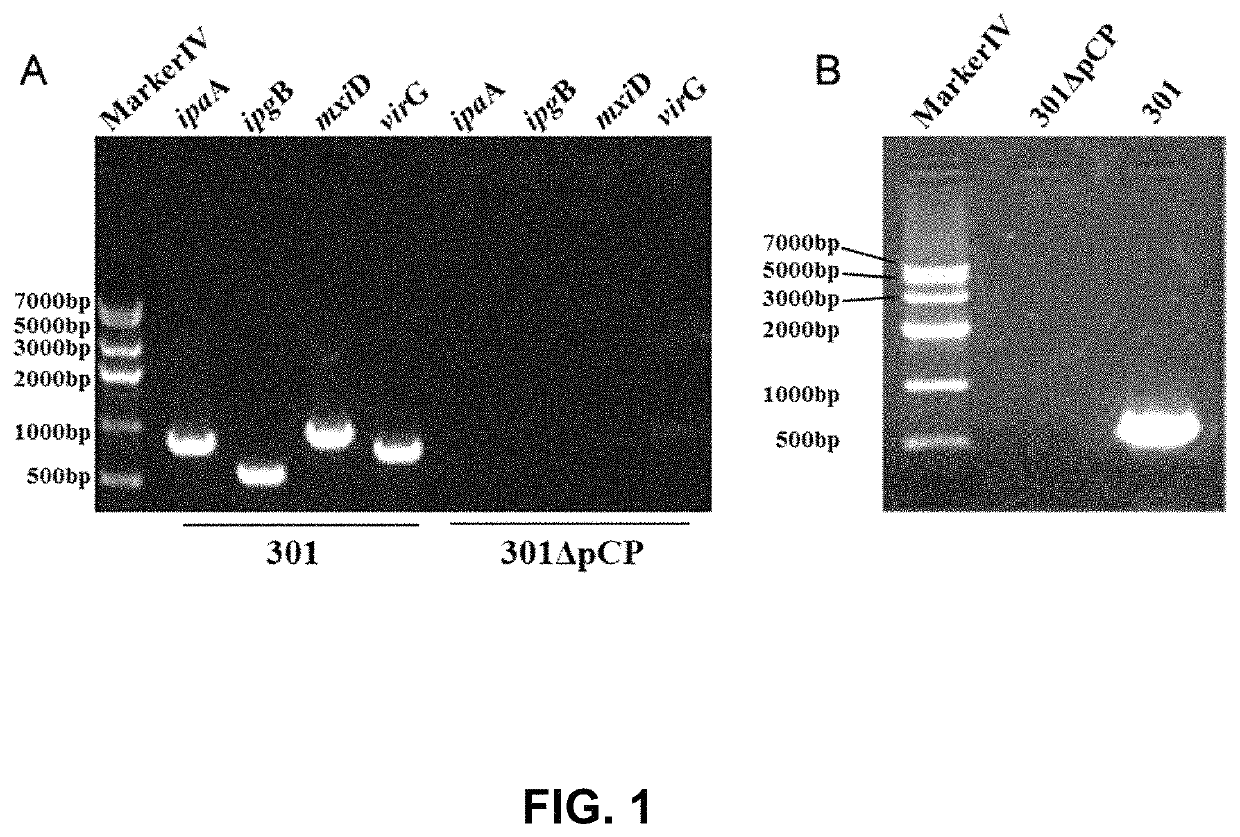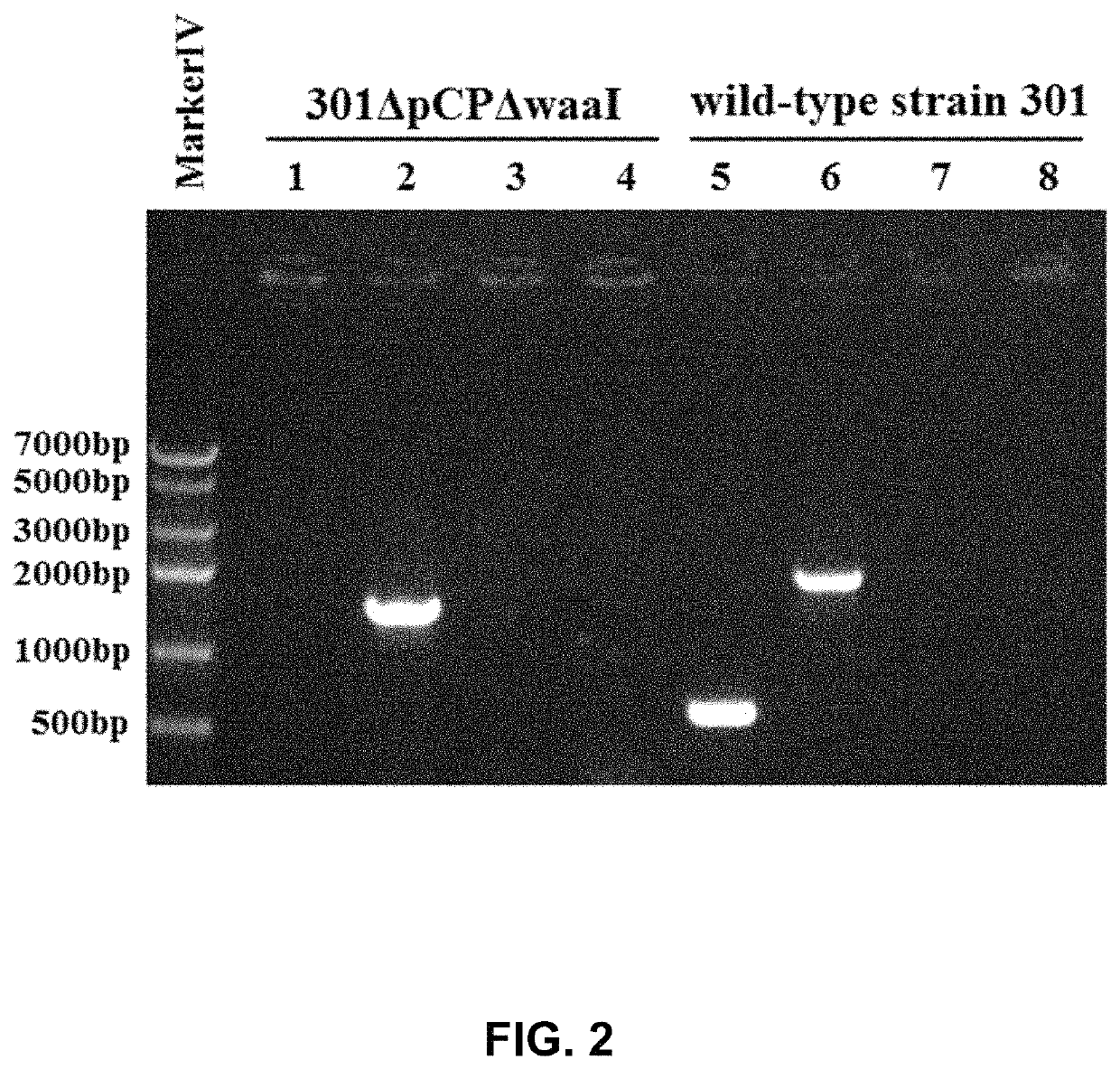Method for preparing bacterial polysaccharide-modified recombinant fusion protein and use of the protein
a technology of recombinant fusion protein and bacterial polysaccharide, which is applied in the field of biomedicine, can solve the problems of weak immunologic memory and immunogenicity of polysaccharide vaccines, low purity, and inability to control quality
- Summary
- Abstract
- Description
- Claims
- Application Information
AI Technical Summary
Benefits of technology
Problems solved by technology
Method used
Image
Examples
example 1
on of Shigella flexneri O-glycosylated Recombinant Fusion Protein and a Vaccine Thereof by One-Step Bioconjugate Method
[0045]Shigella spp. is a highly infectious Gram-negative pathogenic enterobacterium, which generally invades the epithelial cells of human colon and is finally located in large intestine, resulting in typical bacillary dysentery (fever, bellyache, tenesmus, and purulent and bloody stool). The large virulence plasmid is the primary pathogenic factor, and the large virulence plasmid comprises about 32 virulence-associated genes, mainly including mxi-spa gene associated with type III secretion system, and virulence genes closely associated with the invasion of bacteria into epithelia, such as ipaBCD and ipgC. In order to develop it into a safe host bacterium, the large plasmid pCP encoding virulent factors has to be deleted first, and then make it be defective in O-antigen ligase gene waaI, so as to develop a host bacterium suitable for the invention.
[0046]I. Host Bact...
example 2
on of Salmonella paratyphi A O-Polysaccharide-Recombinant CTB Fusion Protein by One-Step Bioconjugate Method
[0222]I. Preparation of O-Antigen Ligase Gene waaL-Defective Salmonella paratyphi A
[0223](I) Preparation of linear targeting DNA fragment
[0224]1. Design and Synthesis of PCR Primers
[0225]According to the waaL gene (GenBank number of CP000026, from positions 3696236 to 3697450) listed in the complete genomic sequence (NC_006511) of Salmonella paratyphi A 50973 strain (S. paratyphi CMCC50973) on NCBI, as well as upstream and downstream sequences thereof, a pair of primers, i.e., 73waaLu1 / 73waaLu2 and 73waaId1 / 73waaLd2, were designed for each of the upstream (5′end) and the downstream (3′end) of Salmonella paratyphi A 50973 waaI gene. For the convenience of operation, the BamHI and SalI restriction enzyme cleavage sites were added to the end of the primer for the upstream homologous arm “up”, and the HindIII and XhoI restriction enzyme cleavage sites were added to the end of the ...
example 3
ion of the Recombinant CTB Fusion Protein with Exogenous O-Polysaccharides of E. coli O157
[0272]When a recombinant fusion protein is modified by an exogenous polysaccharide, it needs a bacterium defective in both O-antigen ligase gene and host O-antigen synthesis, as a host. When O-antigen ligase gene is deleted, no matter the polysaccharides expressed in the host bacterium are endogenous or exogenous, they cannot be utilized in LPS synthesis pathway in the host, while the O-antigen synthesis deficiency in the host ensures that the glycosylation system only utilizes exogenous polysaccharides to modify the recombinant fusion protein, thereby avoiding the contamination due to the modification of the recombinant fusion protein with the endogenous O-antigen polysaccharides in the host. In a host bacterium, a recombinant fusion protein gene, Neisseria meningitidis O-oligosaccharyltransferase PglL gene, a gene cluster for synthesis of exogenous polysaccharide, are co-expressed in the host...
PUM
| Property | Measurement | Unit |
|---|---|---|
| temperature | aaaaa | aaaaa |
| temperature sensitivity | aaaaa | aaaaa |
| concentration | aaaaa | aaaaa |
Abstract
Description
Claims
Application Information
 Login to View More
Login to View More - R&D
- Intellectual Property
- Life Sciences
- Materials
- Tech Scout
- Unparalleled Data Quality
- Higher Quality Content
- 60% Fewer Hallucinations
Browse by: Latest US Patents, China's latest patents, Technical Efficacy Thesaurus, Application Domain, Technology Topic, Popular Technical Reports.
© 2025 PatSnap. All rights reserved.Legal|Privacy policy|Modern Slavery Act Transparency Statement|Sitemap|About US| Contact US: help@patsnap.com



